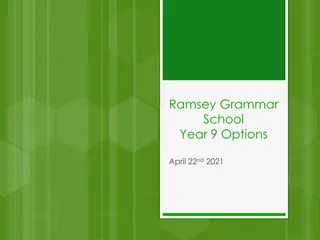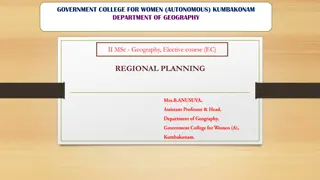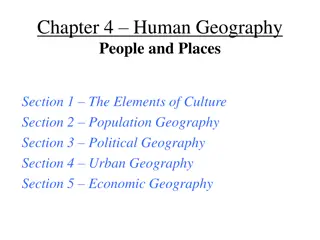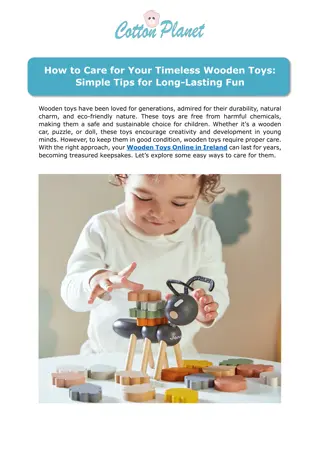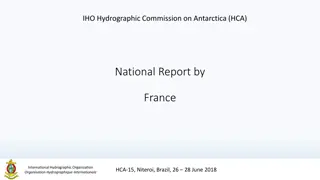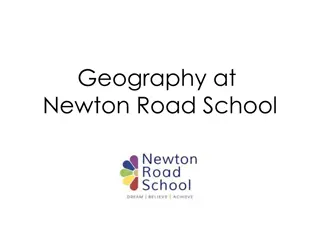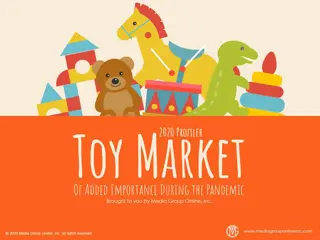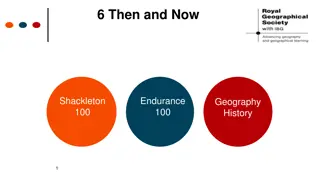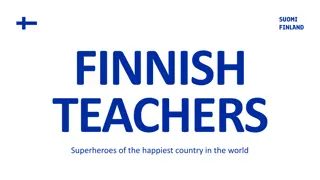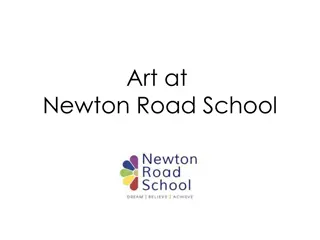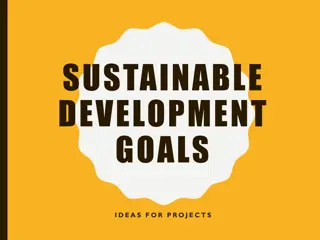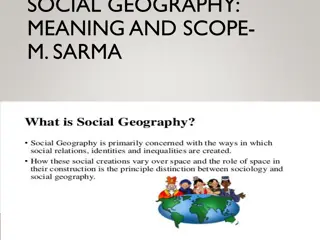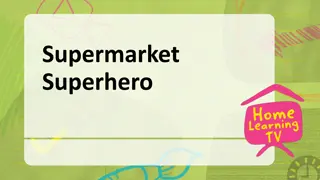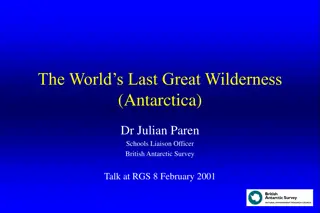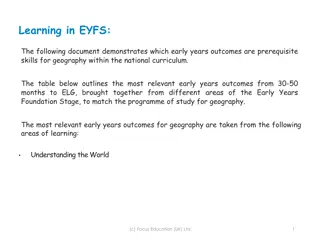Exploring History and Geography Through School, Toys, Superheroes and Antarctica
Dive into a captivating journey of historical and geographical exploration as Newton Road School delves into various exciting topics throughout the academic year. From discovering the history of toys to learning about courageous superheroes like Florence Nightingale and Mary Seacole, this curriculum offers a rich tapestry of educational experiences. Students also embark on a fascinating adventure to the icy landscapes of Antarctica and explore the art of mapmaking. Join us as we explore the past, present, and distant regions of the world through the lens of history and geography.
Download Presentation

Please find below an Image/Link to download the presentation.
The content on the website is provided AS IS for your information and personal use only. It may not be sold, licensed, or shared on other websites without obtaining consent from the author. Download presentation by click this link. If you encounter any issues during the download, it is possible that the publisher has removed the file from their server.
E N D
Presentation Transcript
History at Newton Road School
Term One Term Two Term Three Term Four Term Five Term Six (History) Me, My School and My Road (History) Toys (History) Superheroes: Florence Nightingale, Mary Seacole (Geography) Antarctica (Geography) Map Makers (History) Kings and Queens (Geography) The Seaside Year 1/2 Cycle A (Geography) London (History) Great Fire of London (Geography) Australia (History) Illustrations changes through time (Geography) Rivers (Geography/Sci ence) Field to Fork Year 1/2 Cycle B (History) Stone Age to Iron Age (Geography) Mountains, Volcanoes and Earthquakes (History) Roman Empire: Impact on Britain (History) Geography/Hist ory- Greece Year 3/4 Cycle A Rushden through the ages (History) Shang Dynasty (Geography) The USA (Geography) Africa (History) Benin (History) Anglo Saxons and Scots (History) Vikings and Anglo Saxons Year 3/4 Cycle B (History) Mythology through time (History) Navigation: The Titanic (History/ Science) Space (Geography) Amazing Amazon (History) Crime and Punishment Year 5/6 Cycle A (History) Conflict: World War 2 (History) (History) Our Rights (Geography) Save the planet (Geography/ Science) Darwin/ Evolution Year 5/6 Cycle B Next Stop: Britain
Term One Term Two Term Three Term Four Term Five Term Six (History) Me, My School and My Road (History) Toys (History) Superheroes: Florence Nightingale, Mary Seacole (History) Kings and Queens Year 1/2 Cycle A (History) Great Fire of London (History) Illustrations changes through time Year 1/2 Cycle B (History) Stone Age to Iron Age (History) Roman Empire: Impact on Britain (History) History- Greece Year 3/4 Cycle A Rushden through the ages (History) Shang Dynasty (History) Benin (History) Anglo Saxons and Scots (History) Vikings and Anglo Saxons Year 3/4 Cycle B (History) Mythology through time (History) Navigation: The Titanic (History/ Science) Space (History) Crime and Punishment Year 5/6 Cycle A (History) Conflict: World War 2 (History) Next Stop: Britain (History) Our Rights Year 5/6 Cycle B
Autumn 1 Autumn 2 Spring 1 Spring 2 Summer 1 Summer 2 Early Learning Goal Children at the expected level of development will: PP1: To be able to name the people that are important to me. PP1: To offer comments about the people that are important to me. PP1: To offer comments and explanations about the important people in my life. PP1: To be able to name and describe some of the different roles in society. PP1: To make links between roles in society and the people that are important to me. PP1: To be able to talk confidently about the people around me and their roles in society. PP1: Talk about the lives of the people around them and their roles in society. PP1: To be able to name the people that live in my home. PP1: To be able to name and describe my family. PP1: To be able to name and think about the roles I would like to do in the future. PP2: To be able to use photos to discuss memories within my own past. PP1: To be able to name some similarities and differences between roles. PP1: To be able to use target vocabulary with accuracy when describing different roles. PP2: To be able to name and talk about what is happening in my life now. PP2: To be able to recall some events that happened in the recent past. PP2: Know some similarities and differences between things in the past and now, drawing on their experiences and what has been read in class. Past and Present PP2: To be able to describe events from the recent past using target vocabulary: yesterday, last week etc. PP2: To know and name how I have changed over time. PP2: To be able to name some similarities and differences in myself and others from the past and present. PP2: To be able to talk about the similarities and differences between the past and present in a range settings (people, places etc). PP3: To be able to name what is happening in the present within stories. PP3: To be about to recall character names and settings in books. PP3: To be able to recognise when a story is set / is referring to the past in the stories I listen to. PP3: Understand the past through settings, characters and events encountered in PP3: To be able to put events in order within a story. PP3: To be able to offer comments and show an understanding of the past when encountered in stories. PP3: To be able to offer explanations about the past when encountered in stories. books read in class and storytelling. PP3:To know the names and roles of some significant individuals from the past. PP3:To know the names and roles of some significant individuals from the past.
Year 1/2 Cycle A
Year 1/2 Cycle A Term One Term Two Term Three Term Four Term Five Term Six Topic and focus Me, My School and My Road Toys Superheroes: Florence Nightingale, Mary Seacole Kings and Queens Changes within living memory. Where appropriate, these should be used to reveal aspects of change in national life The lives of significant individuals in the past who have contributed to national and international achievements. Some should be used to compare aspects of life in different periods Significant historical events, people and places in their own locality. The lives of significant individuals in the past who have contributed to national and international achievements. Some should be used to compare aspects of life in different periods NC Objectives:
Year 1/2 Cycle A Term One Term Two Term Three Term Four Term Five Term Six Topic Me, My School and My Road Toys Superheroes: Florence Nightingale, Mary Seacole Kings and Queens Golden Threads Society Society Significance and Conflict Leadership, Society and Significance Vertical Links Horizontal Links Art and Design: Drawing - sel Diagonal Links
Year 1/2 Cycle A Term One Term Two Term Three Term Five Topic and focus Me, My School and My Road Toys Superheroes: Florence Nightingale, Mary Seacole Kings and Queens Knowledge Know when they were born and where this sits on a timeline Know what modern day life is like for them (this will be personal to the children) Newton Road Infant School was opened on 20th November 1894 CE, during the Victorian reign. The hall in the building used to have a gallery, where people could watch the progress of children. The building consisted of one large hall and 7 classrooms, allowing for 460 children to be in the school overall. There were two babies rooms, which is where the office and hive is now. Each room could fit 50 children in. To the west of the hall there are two classrooms built for 60 children in each class. To the north there were 3 more classrooms, each having a capacity of 60 children. The hall was also a designated area for learning and could allow 60 children. Newton Road Junior School opened a few years later and was a separate building to the infants. The schools merged together to form a school for children in Reception to Year 6. We can use photographs to compare the past to now. Schools have changed over time, including Newton Road School. The uniform children wore is different to our school uniform today. Lessons and the school day were different at Newton Road in the past too. Newton Road School is on Newton Road. Newton Road wasn t originally as big as it is today and parts of it had different names. The homes and shops on the street were first numbered in 1898 but the umbers changed in 1930s. The buildings had to add 16 onto their original number to give them a new building number. Some buildings and homes have plaques on them with names or dates. The plaques tells us when the house was made or who occupied the house. The design and style of the buildings and homes have changed over time. 100 years ago it was 19__. We can place events onto a timeline to show the past to present . Chronology is the order of time . timelines are in chronological order Toys have changed over the past 100 years. Toys can be described by their material plastic, wooden, fabric (soft and fluffy). Wooden toys are strong and durable. Plastic toys can be washed and cleaned easier. Modern toys are new toys that we would play with today. A decade is 10 years and is used to describe parts of time in the past. For example, the 1970s. Parents and Grandparents had different toys to play with compared to present day. The production of electronics and computers means more todays today are electrical. Some toys have continued to be played with over the decades Lego, teddy bears, hula hoops. In the past, many toys were hand-made by skilled craftsman. Modern toys are often made in factories In Victorian times, poor children played with homemade toys like dolls, marbles and balls and rich children had rocking horses, puzzles, train sets and board games. Toys and games from the past had similarities across the world and different cultures. Some toys from across the world include: Uta Garuta, Diabolo, Stacking Dolls, Sungka, Carrom. Florence Nightingale was born in 1820 in Florence, Italy and moved to England as a baby. She was alive when Queen Victoria was Queen of England. During this time, men and women; rich and poor weren t treated equally. Florence Nightingale was educated at home by her father. Florence trained to be a nurse. Britain went to war with Russia, known as the Crimean War, which took place in Crimea, in October 1853. Florence, as a trained nurse, travelled to a hospital in Scutari (where wounded soldiers from the war went). Florence travelled with 38 other nurses to the Crimean War. Florence found issues with the hospital: overcrowding, unclean and blocked drains, not enough medical equipment, not enough beds and blankets, no food, contaminated water nothing to drink, lice and rats were there, sliders were dying from infections . Florence and her team improved the quality of the hospital. Florence would check up on patients over night to comfort them, using candlelight to find her way. Florence met with Queen Victoria, who was so shocked by what Florence had found on her arrival in Scutari, that she agreed to set up the Royal Establishment for the Health of the Army. Mary Seacole was born in 1805 in Jamaica to a Scottish father and a Jamaican mother. Her mother was a famous healer in Jamaica and she taught Mary all her skills. During the Crimean War, she read that Florence Nightingale was looking for some nurses to go and help her. Mary Seacole travelled to London for an interview to travel with Florence to Crimea as a nurse to help but was not successful. Mary was not a nurse but had learnt skills from her mother. She found her own money to pay for herself to travel to Crimea. When Mary arrived she set up a hotel The British Hotel to care for wounded soldiers and fed them hot meals. A monarch is a king, queen or emperor There have been many British Monarchs, with King Charles III our current monarch The longest serving British Monarch is Queen Elizabeth II. Henry VIII is one of the most famous kings in British history. He was the second of the Tudor monarchs, taking the throne when his father, Henry VII, died. The Tudors were a family who came to power in 1485 when Henry Tudor defeated King Richard III at the Battle of Bosworth. Henry VIII was born on 28th June 1491 in Greenwich, England. Henry VIII became king on 24th June 1509, and reigned until his death on 28th January 1547 at the age of 55. He was king for almost 38 years. Henry VIII is most famous for having 6 wives. Henry VIII created the Church of England Those who followed the new Church of England were called Protestants. Henry's changes meant that religious worship in England had changed forever. Queen Victoria was born on 24 May 1819 in Kensington Palace in London, England. Her full name was Alexandrina Victoria. Victoria became Queen of England in June 1837, when she was just 18 years old. Her coronation took place. at Westminster Abbey a year later in June 1838. Queen Victoria's reign is known as the Victorian era. Ruling for over 60 years, Victoria would become the longest reigning British Monarch, and Queen of the biggest empire in history. During her time as Queen, the British Empire included Australia, New Zealand, Canada, South Africa and India. Until Queen Elizabeth II, Queen Victoria was the longest serving British Monarch Queen Victoria had 9 children with her husband Prince Albert. After his death in 1861, she wore black for the rest of her life. Her reign saw the greatest transformations and innovations(trains for transport, all children going to school, more factories) during Victorian Britain,
Year 1/2 Cycle A Term One Term Two Term Three Term Five Topic and focus Me, My School and My Road Toys Superheroes: Florence Nightingale, Mary Seacole Kings and Queens Skills Sequence events in their life Sequence photographs etc. from different periods of their life Recognise the difference between past and present in their own and others lives Recount episodes from stories about the past Identify differences between ways of life at different times Compare adults talking about the past how reliable are their memories? Find answers to simple questions about the past from sources of information e.g. artefacts Communicate their knowledge through; discussion, drawing, pictures, drama/role play, making models, writing and using ICT Sequence 3 or 4 artefacts from distinctly different periods of time Match objects to people of different ages Sequence artefacts closer together in time Describe memories of key events in lives Recognise the difference between past and present in their own and others lives Identify differences between ways of life at different times Compare adults talking about the past how reliable are their memories? Find answers to simple questions about the past from sources of information e.g. artefacts Communicate their knowledge through; discussion, drawing, pictures, drama/role play, making models, writing and using ICT Find answers to simple questions about the past from sources of information e.g. artefacts Recognise why people did things, why events happened and what happened as a result Identify differences between ways of life at different times Communicate their knowledge through; discussion, drawing, pictures, drama/role play, making models, writing and using ICT Use stories to encourage children to distinguish between fact and fiction Find answers to simple questions about the past from sources of information e.g. artefacts Identify differences between ways of life at different times Recognise why people did things, why events happened and what happened as a result Communicate their knowledge through; discussion, drawing, pictures, drama/role play, making models, writing and using ICT
Year 1/2 Cycle B
Year 1/2 Cycle B Term One Term Two Term Three Term Four Term Five Term Six Topic and focus Great Fire of London Illustrations changes through time NC Objectives: Events beyond living memory that are significant nationally or globally Changes within living memory. Where appropriate, these should be used to reveal aspects of change in national life
Year 1/2 Cycle B Term One Term Two Term Three Term Four Term Five Term Six Topic Great Fire of London Illustrations changes through time Golden Threads Significance Significance Vertical Links Horizontal Links Diagonal Links
Year 1/2 Cycle B Term Two Term Five Topic and focus Great Fire of London Illustrations changes through time Knowledge King Charles II was the ruling monarch at the time of the Great Fire. London was divided into the wealthy west and the working-class east. Most of London s residents didn t have access to clean water. Plagues and illnesses were spread quickly due to poor hygiene. Most people worked for a master and common jobs included: chimney sweeper and spinster. The Great Fire of London was a significant event. The Great Fire of London began on Sunday 2nd September 1666. The fire started on Sunday during the night in a bakery in Pudding Lane - owned by Thomas Farriner. The fire burnt down a quarter of London. The fire spread quickly for many reasons: most of the buildings were made from wood, the buildings were incredibly dry to a long, hot summer, buildings were cramped close together and the strength and direction of the wind. Know that later in the morning people began to hear the news of the fire and many left their homes with all their belongings. The King was told of the fire, and he ordered the Mayor to knock down any houses that might be in the way of the fire to stop it spreading. They tried pulling down houses and even blowing them up to stop the fire spreading even further. The River Thames was used by people escaping from the fire. On Thursday evening all the fires had been put out. An eyewitness is someone who has seen an event in real life and can describe it. Samuel Pepys saw the fire and that he wrote about it in his diary. His diary is an important source of information about the Great Fire. We can use a range of sources, including eyewitness accounts, diaries, paintings etc to build up a reliable picture of what happened. There are lots of paintings of the Great Fire, some were not painted while the fire was happening and were imagined by the artist. Some sources of evidence are more reliable than others. There was initial hesitation into putting out the fire. Lots of people worked together to fight The Great Fire although most citizens were more concerned about saving their belongings than putting out the fire Fire hooks were used - to pull houses down to create gaps to stop the fire from spreading. Leather buckets were used to throw water on the fire. Fire Squirts were used. They were like a huge syringe. The pointed end was put in a bucket of water, the handle was pulled out, to suck the water up. Then it was aimed, the handle was pushed and the water squirts out. Simple fire engines were used. They were very simple, a barrel on wheels with a pump in the centre. Gunpowder was used to blow up building to create fire breaks. Know that King Charles II proposed recommendations to prevent such a disaster happening again: Any future buildings should be constructed from brick and stone. All streets should be widened all alleys and small lanes were to be banned. No houses to be built near the River Thames. Any trades that used fire in order to manufacture goods should Beatrix Potter was an author and illustrator, who lived during the Victorian times. She was born in 1866. (Place Beatrix Potter on timeline.) Beatrix was born into a rich family, so did not attend school but was educated at home with a governess. During holidays she would enjoy drawing animals and wildlife in the countryside. In her twenties she was interested in studying nature and she wrote several papers about her findings however because she was a woman no one took her ideas seriously. Life in Victorian times was very different to today - rich women were expected to get married and have children, they rarely had jobs. Beatrix started selling illustrations of plants and animals to a company that made greetings cards. Beatrix created her illustrations by drawing and using watercolours. She sent an illustrated letter to her governess's son with the tale of Peter Rabbit. She wanted to publish this story but it was turned down by publishers six times. She decided to privately publish it (250 copies) as The Tale of Peter Rabbit (1901). In 1902 it was published commercially with great success by Frederick Warne & Company. Roger Hargreaves is a British author and illustrator born in 1935. (place Roger on timeline). Roger worked in advertising. He originally wanted to be a cartoonist. In 1971 he created characters that were used in adverts on television. Also, in1971 he wrote the first Mr Men book Mr Tickle. He initially had difficulty in finding a publisher, but once he did, the books became an instant success. Mr Men and Little Miss books are still hugely popular today - Quentin Blake is an English cartoonist, caricaturist, illustrator and children's writer. He was born in 1932 still alive today. (place Quentin on timeline). He has drawn ever since he can remember. His first drawings were published in Punch while he was 16 and still at school. He has always made a living as an illustrator and was also a teacher at the Royal College of Art. In 1970, he started illustrating Roald Dahl books. Quentin Blake has illustrated over 500 books. His books have won many prizes and awards. In 1999 he was appointed the first ever Children's Laureate, a post designed to raise the profile of children's literature. He received a knighthood for 'services to illustration' in the New Year's Honours for 2013 and was appointed 'Companion of Honour' in the Queen's Birthday Honours List in 2022. Lauren Child is an English children's author and illustrator. She was born in 1965 still alive today. (place Lauren on timeline) Know that Rob Biddulph is an English author and illustrator still alive today.
Year 1/2 Cycle B Term One Term Two Term Three Term Four Term Five Term Six Topic and focus Great Fire of London Illustrations changes through time Skills Sequence a set of events in chorological order and give reasons for their order Compare 2 versions of a past event Compare pictures or photographs of people or events in the past Discuss reliability of photos/ accounts/stories Find answers to simple questions about the past from sources of information e.g. artefacts Recognise why people did things, why events happened and what happened as a result Communicate their knowledge through; discussion, drawing, pictures, drama/role play, making models, writing and using ICT Use a range of appropriate words and phrases to describe the past Use the words past and present correctly Use words and phrases such as past present, before after then now in my historical learning Recount some interesting facts about a historical event Compare pictures or photographs of people or events in the past Use a source observe or handle sources to answer questions about the past on the basis of simple observations Recognise why people did things, why events happened and what happened as a result
Year 3/4 Cycle A
Year 3/4 Cycle A Term One Term Two Term Three Term Four Term Five Term Six Topic Stone Age to Iron Age Roman Empire: Impact on Britain Rushden through the ages Greece Ancient Greece a study of Greek life and achievements and their influence on the western world NC Objectives: Pre-Roman Britain Pupils should be taught about changes in Britain from the Stone Age to the Iron Age Roman Britain Pupils should be taught about the Roman empire and its impact on Britain Local History Pupils should be taught about an aspect of local history The shoe and boot industry in Rushden is the focus for this unit of work
Year 3/4 Cycle A Term One Term Two Term Three Term Four Term Five Term Six Topic Stone Age to Iron Age Roman Empire: Impact on Britain Rushden through the ages Greece Golden Threads Society Conflict, Religion, Leadership and Significance Society and Significance Economy, Religion and Societywss Vertical Links Year 1/2A: Making maps Year 1/2A: Toys Year 1/2A: Me, my school, my road Year 1/2B: Antarctica Year 1/2B: Australia D&T: Food Healthy and varied diet Horizontal Links Geography Greece Diagonal Links
Year 3/4 Cycle A Topic Term One Stone Age to Iron Age Knowledge Prehistory means before history (pre means before). It refers to the time before history was written and recorded Archaeologists are historians who find out about the past by looking at what people have left behind Artefacts are objects made by humans We use chronological timelines to show how long ago events and periods of time happened it also indicates how long these events happened for There are 3 Stone Age eras: Palaeolithic era, the old Stone Age; Mesolithic Era, the middle Stone Age and Neolithic Era, the new Stone Age The first humans were found in Africa The Palaeolithic Era occurred 2.5 million years ago 12,000 years ago During the Palaeolithic era: humans moved out of Africa and were hunter-gatherers, started to use fire, slept in temporary and natural shelters, used basic tools made from wood and bone, spoke little language At the end of the Palaeolithic era and start of Mesolithic Era, Europe (including Britain) changed its appearance The Mesolithic Era (10,500BE 4,000BCE) occurred 12,000 years ago 6,000 years ago Sources and artefacts from digs place home sapiens in Britain around 40,000 years ago The Neolithic Era (4,000BCE 2,500BCE)occurred 6,000 to 4,500 years ago. During this era, humans gave up the hunter-gatherer lifestyle and began to farm and stayed in one place for longer. The main materials they used were bone, flint and animal skin Similarities between all 3 eras include: musical instruments, the use of a hammer stone, cave art, bread Difference between all 3 eras include: pottery (first made in the Mesolithic era), language development, the way they settled Artefacts uncovered during the Stone Age reveals aspects of how they lived flint cutting tools, jadeite axe, saddle quern, spear tips, necklaces, Neolithic humans settled in Skara Brae and was uncovered by a huge storm Skara Brae was uncovered in the 1850s and was at least 5,000 years old The buildings and artefacts are still intact and can be seen this gives us an insight to our history Stonehenge is located in Somerset, UK and is over 5,000 years old It took over 1,000 years to build and is bade from Bluestone arches The stones marks the summer and winter solstice (At the summer solstice, the Sun reaches its highest point of the year, while at the winter solstice, the noon Sun is the lowest it will be all year) Prehistory is split into 3 ages: Stone Age, Bronze Age and Iron Age The Bronze Age (2,500BCE 800BCE) began 4,500 years ago and is called this because humans found a way of making tools and weapons with a metal. Copper + tin = bronze The Bronze Age marked the first time there was a difference between people who had may belongings and those that didn t (rich/poor) The rich could afford the metal and began to swap and trade and people who were skilled wit metal were deemed more important. Trading goods began all over Europe, as travel by foot and boat grew. Hill forts were built with walls to stop raiders taking camps or animals a way of protection Archaeologists have discovered that people often threw bronze axes and swords into rivers and believe this was done as an offering to the water spirits and gods in return for good weather. This shows that people had developed spiritual beliefs. The Baker Culture began in central Europe around 2,800BCE and spread the ideas, skills, knowledge and religion. This also included how to make bronze/iron The Iron Age (800 BCE 43CE) and was called this due to the Celtic people migrating and trading across Europe into Britain. They brought with them their culture, including how to make Iron. Iron was more difficult to make than bronze and not as good as bronze but it was easier to make due to materials being more widespread. Villages were built on hills to make them difficult to attack and walls would be used to protect them. This is because tribes would raid resources agriculture, archaeology, archaeologist, artefact, bronze, era, flint, hillfort, hunter- gatherer, forage, homo sapiens, iron, migration, monument, Neanderthals, Neolithic, period, pre-historic, roundhouse, settlement, site, smelting, thatched, trade, tribe Vocabulary
Year 3/4 Cycle A Topic Term Three Roman Empire: Impact on Britain Knowledge The Roman Empire in 150 C.E covered the majority of Europe, parts of Africa and Western Asia. It was the largest empire of the ancient world. Romulus and Remus were two brother who built the city of Rom. When they were babies, the King wanted them dead, so they wouldn t claim to rule. The two brothers were raised by wolves. Romulus killed his brother to become King of Rome. Rome began to expand and they had a well trained army. This added to their power. Before the Roman invasion, Britain was a celt tribal society with no national leader There were two failed Roman invasions to Britain in 55 B.C.E and 54 B.C.E In 43 C.E Britain was living in the Iron Age In 43 C.E, the Romans invaded Britain again, in the hope of Claudius (the leader) expanding the Roman Empire. They settled and ruled the country for almost 400 years until 410 C.E. The Roman Army was: well trained, well equipped and well organised. This helped them to conquer so much land. The Celtic Army was: poorly equipped and had a chaotic fighting style. The Iceni tribe lived in where the county of Norfolk, England is today. It was led by King Prasutagus and Queen Boudicca and were forced to an agreement with a Roman Governor(Gaius Suetonius Paulinus), was that King Prasutagus could keep half his land but had to give the other half to the new Roman Emperor Nero. It was promised that when the King Prasutagus died, his land would go to his daughters. When the King died, he Romans didn t keep their promise and took over his land and took the money from people living there (including extra taxes). Queen Boudicca complained and was attacked by the Romans. She gathered nearby tribes to join her army, in which she leads. They travelled to Colchester (a Roman town) and attacked the soldiers and burned the town down. After Colchester, the Ninth Legion tried to stop Boudicca but her huge army defeated them. Boudicca s army continued to attack the Roman cities of Londium and Verulamium. The Romans used effective tactics to kill about 80,000 f Boudicca s army and win the battle. Boudicca poisoned herself to avoid being captured. The Romans built roads in Britain, so they could move troops quickly and easily and they tried to build straight roads to make journeys faster. Romans built Britain s first downs. In the middle was a square called a forum which is where news was announced, markets held and business deals made. Romans built aqueducts to carry water from springs, rivers or lakes. Romans built underground drains to take away dirty water and sewage. Romans created central heating and indoor plumbing. Romans built public baths all over Britain, where people went to wash and bathe. Most Romans lived in small, wooden houses with thatched roofs. The wealthy Romans lived in villas. In 285 C.E, Emperor Diocletian decided the empire was too big and split it into two parts: Western Roman Empire, controlled by Rome; Eastern Roman Empire, controlled by Constantinople (modern day Istanbul). From 407 C.E, Romans faced invasions in the Western Empire. This meant that Roman soldiers had to leave Britain to defend in the army, with the last soldiers left in 410 C.E. The Roman Empire collapsed because it became too big. Vocabulary battle, conquer, emigrate, emperor, empire, gladiator, immigrate, invade, legion, legionnaire, revolt, senate, settlers,
Year 3/4 Cycle A Term Four Topic Rushden through the ages Knowledge Rushden means rushy valley and its history dates back about 10,000 years ago. There are signs of Bronze Age settlements in the area, as well as an Iron Age site excavated near Boundary Avenue. There is evidence of Roman sites found in Hayway area and Higham Park. In Anglo Saxons times, the area including Rushden, together with Higham Ferrers, Irchester, Raunds and Wollsaton was known as the Higham Hundred. The main occupation of the village of Rushden was agriculture. As the village grew into a town, in the 1950s 44% of Rushden trade was boot and shoe making. In 1849 there were only 6 shoe makers, 40 years later in 1889 there were 61 shoe makers. As the shoe industry grew in Rushden, so did the growth in employment and house building. The village grew from agricultural land and 320 houses to a flourishing industrial town by 1850. Two World Wars causes great demand for army boots for troops, which manufacturer John White supported. The shoe trade made Rushden firms some of the biggest shoe manufacturers in the UK. John White Footwear Ltd made 8 million pairs of army boots during WW2. Northamptonshire is and has been known as a shoe making county. In 1859, factories were becoming industrialised and had machinery to help them with shoe production. Shoe making was a big industry across the county, with many shops running within the towns. Starting in 1901, the Griggs family were known for making boots in the small town of Wollaston, Northamptonshire in the English Midlands. They were at the very heart of the English shoe industry and for six decades Griggs footwear earned a solid reputation as sturdy, durable work boots. Klaus Maertens, a 25-year-old soldier. While convalescing from a broken foot he created a unique air-cushioned sole (rather than the traditional hard leather sole) to aid his recovery. Using a salvaged cobbler s last and a needle, Maertens made a prototype shoe and showed it to an old university friend and mechanical engineer, Dr. Herbert Funk. The 1960s the decade in which the Dr. Martens boot was born saw an unprecedented wave of change, new ideas, cultural upheaval and eventually social revolution. This radical atmosphere also witnessed extravagant and often exotic fashion, an odd backdrop for the birth of such a functional work-boot ... but then Dr. Martens has always kicked against the norm. Some shoe factories are still running and are open across Rushden and Northampton (visit this compare photos and history of shoe making, shoe museum in Northampton supports this too). economy, employment, heritage, industry, locality, trade, trader workers, poverty, wealth Vocabulary
Year 3/4 Cycle A Topic Term Six Greece Knowledge The Ancient Greece civilisation can be broken into three main periods: o The Archaic Period (900 BCE to 480 BCE) o The Classical Period (480 BCE to 323 BCE) o The Hellensistic Period ( 323 BCE to 146 BCE) The Greek civilisation began to decline in 146 BCE when the Romans conquered Greece, making it part of the Roman Empire. Ancient Greece had no central government. Polpe lived in city- states called polis. At the cente was a powerful city, which ule the area. There were three main forms of government in Greece: o Monarchy Ruled by a king o Oligarchy Ruled by a small group of people o Democracy Ruled by many people The word oligarchy comes from the Greek root words oligos meaning few and arkhein meaning rule. The word democracy comes from the Greek root words demos meaning people and kratos meaning power . Democracy was established in the city of Athens in around 508 BCE. Solon was appointed ruler of Athens in 594 BCE. Solon proposed to cancel all debts and reformed the class system within Athens. Citizens voted for every law. Most officials were chosen by a lottery. In order to vote, you had to be a citizen. Only men who had completed their military training were counted as citizens. Today, most countries claim to have democratic forms of government. Hippocrates famous for his ideas about medicine. Doctors still take an Hippocractic Oath (promising to be honest). Plato Famous philosopher for asking questions, such as How d we think?, which are questions philosophers still use today. Aristotle studied plants, animals and rocks. He carried out experiments to find out about the world we live in, which modern scientists still do today. The Greeks invented modern mathematics, sculptures, philosophy and science. Greek architecture can still be seen across the world today such as the Supreme Court The English language has roots linked to Ancient Greece and some full words are Greek such as helicopter. Every 4 years the Olympic Games were held in Olympia. The first games were in 776 BCE and more events were added each year (wrestling, chariot racing, boxing). This inspired the modern Olympics, which began in 186 CE. Athletes rayed to Nike, the goddess of victory Greeks watched races in open air stadiums, similar to modern sports stadiums Greek men and boys trained in gymnasiums, like modern day gyms which are welcome to all. Legend tells of Pheidippides, who fought at the battle of Marathon. When the Greeks won, he ran 26 miles (42 km) to Athens with the news and then fell down dead. Modern marathon races cover the same distance as his epic run.
Year 3/4 Cycle A Term One Term Three Term Four Term Six Topic Stone Age to Iron Age Roman Empire: Impact on Britain Rushden through the ages Greece Skills Place the time studied on a time line Use terms related to the period and begin to date events Understand more complex terms (BCE and CE) Identify key features and events of time studied Look for links and effects in time studied Find out about everyday lives of people in time studied Compare with our life today Identify reasons for and results of people's action Understand why people may have wanted to do something Recall, select and organise historical information Communicate their knowledge and understanding Look at evidence available Begin to evaluate the usefulness of different sources Use textbooks and historical knowledge Place events from period studied on time line Use terms related to the period and begin to date events Understand more complex terms (BCE and CE) Use evidence to reconstruct life in time studied Find out about everyday lives of people in time studied Identify key features and events of time studied Offer a reasonable explanation for some events Look at the evidence available and begin to evaluate the usefulness of different sources Use text books and historical knowledge Recall, select and organise historical information Communicate their knowledge and understanding Place events from period studied on time line Look at the evidence available and begin to evaluate the usefulness of different sources Use text books and historical knowledge Choose relevant material to present a picture of one aspect of life in time past Ask a variety of questions Use the library and internet for research Place events from period studied on time line Use terms related to the period and begin to date events Understand more complex terms (BCE and CE) Identify key features and events of time studied Look for links and effects in time studied Choose relevant material to present a picture of an aspect of life in time Ask a variety of questions Use the library and internet for research
Year 3/4 Cycle B
Year 3/4 Cycle B Term One Term Two Term Three Term Four Term Five Term Six Topic Shang Dynasty Benin Anglo Saxons and Scots Vikings and Anglo Saxons NC Objectives: Ancient Civilizations Pupils should be taught about the achievements of the earliest civilizations an overview of where and when the first civilizations appeared and a depth study of one of the following: The Shang Dynasty of Ancient China Non-European Study Pupils should be taught about a non-European society that provides contrasts with British history - one study chosen from: Benin (West Africa) c. AD 900-1300 Anglo-Saxons & Scots Pupils should be taught about Britain s settlement by Anglo-Saxons and Scots Anglo-Saxons & Vikings Pupils should be taught about the Viking and Anglo- Saxon struggle for the Kingdom of England to the time of Edward the Confessor
Year 3/4 Cycle B Term One Term Two Term Three Term Four Term Five Term Six Topic Shang Dynasty Benin Anglo Saxons and Scots Vikings and Anglo Saxons Golden Threads Leadership, Religion and Society Economy and Leadership Conflict, Leadership, Religion and Society Conflict, Leadership and Society Vertical Links Horizontal Links Diagonal Links
Year 3/4 Cycle B Term One Topic Shang Dynasty The Shang was based around the Yellow River in China (Asia) and the civilisation lasted from around 1600 B.C.E to 1046 B.C.E The Shang Dynasty ruled during the Bronze Age period in Britain. Archaeologists find and discover artefacts from the past. The Shang dynasty was the first dynasty able to be studied by archaeologists because there are written records and artefacts. Shang Dynasty were the first to use writing which was sketched on to bones, known as oracle bones. Archaeologists have found these which tell us: what they believed, who their emperors were, wars and how people lived. The Shang dynasty was a Bronze Age civilisation and was very skilled at bronze craft. Bronze doesn t rot away or break down very easily. That means that archaeologists can dig up bronze items and learn more about how people in the Shang Dynasty lived. The artefacts from the Shang Dynasty have been found in the last 100 years and they are still finding artefacts today. Whilst the Shang Dynasty was happening in China, early civilisations were appearing all around the world. Some were more advanced than others. E.g., Ancient Egypt, Olmec Civilisation thriving in Mexico, in Greece the Temple of Delphi was being built, in Britain Celts had learnt to make bronze. Before the Shang Dynasty was the Xia Dynasty. Emperor Jie led the Xia Dynasty. Emperor Jie was disliked; he did not rule the kingdom well and was unkind to his people. In China anyone could become emperor they needed the Mandate of Heaven to rule. A noble man and warrior Chen Tang saw the Mandate of Heaven and decided he was going to take over and be in charge of the Shang people. Chen Tang lowered taxes and reduced the number of people who became soldiers. After he became emperor there was a huge drought, in which he offered to sacrifice himself to have rain He united different tribes living around Yellow River and made special gold coins to give to poor families. Chen Tang led the people in the battle of Mingtiao. Chen Tang was victorious and became the new emperor. Chen Tang was seen as a popular and successful leader. There was a social class hierarchy during the Shang Dynasty. This consisted of: Shangdi, the Emperor, the noble class: royal family, landowners, priests, the working class: farmers, soldiers, craftsmen. Most people wouldn't be in the noble class, they would be in the working class. Life was hard without much money and food to eat. Life was easier for the noble class - they lived in grand palaces, had plenty of nice food including meat. The most powerful person in ancient Chinese society was the emperor. However, the Shang were religious people, and believed that the emperor was allowed to rule by the highest God (or supreme deity ), called Shangdi. The Yellow River is called that because it has lots of silt in it which makes it appear yellow in colour. It allowed very fertile lands for growing crops. Most people living in the Shang Dynasty were farmers, and they would grow wheat, millet and barley on the banks of the river. They could turn this wheat into flour and make bread. A normal meal for people in the Shang Dynasty would be bread and beer. In 1976 a tomb from the Shang Dynasty was discovered by archaeologists. The discovery of Fu Hao's tomb was significant because it provided us with knowledge of Fu Hao and how Shang society was organised, their traditions and customs and the importance of the artefacts. They found amazing jade artefacts, precious stones and jewellery, bronze weapons, thousands of cowrie shells, six dog skeletons and seventeen human skeletons. Fu Hao was one of Emperor Wu Ding s most important wives. Wu Ding was one of the most successful emperors. Fu Hao was a military general (It would have been very unusual for a woman to be a military leader) and a priestess and politician. The many special items in Fu Hao s tomb show just how important she was. The Shang Dynasty was a hugely successful civilisation. It lasted for over 500 hundreds years and the position of emperor passed down through 17 generations. Successes of the Shang Dynasty: invented writing. They crafted amazing bronze vessels and weapons. They created beautiful jade and stone artwork objects and statues. They mapped the stars, the moon and the planets and learnt that a year is exactly 365 and 1/4 days long. The last emperor of the Shang Dynasty was King Zhou, also know as Di Xin, Wu Deng. King Zhou was a terrible, cruel king. He stopped looking after his people and enjoyed lots of luxuries and taxed his people heavily for this. He and his wife also gave out horrible punishments e.g. throw them into a pit of poisonous snakes and scorpions. In 1066 a mandate of heaven was seen by the Zhou Dynasty and they sent an army led by the military commander Jiang Ziya to the Shang capital. Lots of Shang people surrendered, Emperor Zhou realised that he would lose the battle and the Dynasty would come to an end. Knowledge Vocabulary agriculture, archaeology, archaeologist, artefacts, bronze, civilisation, deity, dynasty, emperor, hierarchy, kingdom, military, tyrant, vessels
Year 3/4 Cycle B Term Four Topic Benin Knowledge Benin is a country in West Africa The modern country called Benin used to be called Dahomey It was renamed Benin on November 30th 1975 The name Benin was chosen after the fallen Benin Empire The modern country of Benin has no connection to Benin City or the Benin Empire Benin City is the capital of the Edo State in Southern Nigeria This is where the founders of the Benin Empire lived and they were known as Edo people The Edo people no longer wanted to be ruled by their dynasty of kings, known as Ogisos Ogisos means kings of the sky The people lived in small communities (a kingdom) known as Igodomingodo. The Kingdom of Benin began in the 900s The Eras of the Kingdom of Benin include: o Dynasty of Ogisos (900-1180 C.E) o Era of Empire Consolidation (1180-1440 C.E) o Era of the Warrior Kings (1440 1605 C.E) o Era of European Missionary Influence (1605 1700 C.E) o British began to take control (1700 1897 C.E) In the 1100s the Ogisos lost control of their Kingdom Around 1180 C.E a new era for Benin began when Eweka began to rule He took the title of Oba, which means King in Yoruba language He changed the name of the kingdom from Igodomingodo to Edo Oba Eweka I ruled from 1180 1246 C.E during the Era of Empire Consolidation During the Era of Warrior Kings there were 5 great warrior kings. o Oba Ewuare Introduced hereditary succession (the heir to the throne is the current king s child). He rebuilt the Benin City and the royal palace, as well as built an army. o Oba Ozolua Believed to have won 200 battles. o Oba Esigie Expanded his kingdom eastwards to form an empire and won land from the Kingdom of Ife. o Oba Orhogbua During his reign, the empire reached its largest size. It stretched beyond the River Niger in the east and extended west as far as present-day Ghana. o Oba Ehengbuda Spent most of his reign stopping rebellions led by local chiefs. Oba Ehengbuda was the last of the warrior kings. After his death in 601, Benin s empire gradually shrank in size. Obas were always men. Women in the royal family had power and influence but couldn t rule An Oba s main responsibility was to be in charge of the military Most of the kingdom s art was made to honour the Obas Between 1300 1700 C.E Benin became a powerful and wealthy kingdom and was situated in the perfect place for trading. The Kingdom of Benin sold goods like pepper, ivory, cloth, leopard skins, beads, rubber, palm oil and precious stones to European trader Benin bought metal from Europeans to use for their plaques and sculptures. European countries were impressed with Benin s arts and crafts. Benin was heavily involved in the West African slave trade they would capture men, women and children from rival peoples and sell them into slavery to European and American buyers The slave trade was a significant source of wealth for the kingdom After 1700 C.E, Benin Kingdom began to decrease in both wealth and power. People began to fight about who should become the next Oba an a series of civil wars led to a decrease in the population The wars prevented arts and goods being created for trade European countries began to ban the slave trade and Benin lost a significant amount of wealth due to this
Year 3/4 Cycle B Term Five Topic Anglo Saxons and Scots Knowledge Sutton Hoo is an archaeological site in Suffolk, England and was discovered in 1939. The site is of an early medieval burial ground that includes the grave of an Anglo-Saxon king. It contains a ship fully equipped for the afterlife and artefacts including coins and gold. Archaeologists are historians who find out about the past by looking at what people have left behind. Artefacts are objects made by humans. The Romans had ruled over Britain for nearly 400 years at the start of the 5th Century. But the Roman Empire had started to collapse, as It had become too big to defend itself and the Empire couldn t afford to pay all the soldiers it needed to hold on to its lands. The Scots attacked from Ireland and the Picts attacked from the North and the Saxons attacked from Europe. Bit by bit the empire was conquered by invaders that the Romans called barbarians (Anglo Saxons) in ships across the North Sea. In 410 C.E the Romans left Britain. The Anglo-Saxon age in Britain was from around 410 C.E - 1066 C.E. Anglo Saxons is a modern name given. The Anglo Saxons were a mix of 3 tribes from: Germany, Denmark and the Netherlands. The 3 biggest tribes were the Angles, the Saxons and the Jutes. The name England is derived from Angle Land meaning land of the angles. By 550 C.E Britain had broken up into many small kingdoms, each ruled by a different leader. By 660 C.E Anglo- Saxons controlled most of Britain. The Scots came from Northern Ireland and the Picts came from Pictland (now known as Scotland) The Picts and Scots lived north of Hadrian s Wall. While the Anglo-Saxons were invading from the sea, the Picts attacked from the north. The Anglo Saxons created 7 different kingdoms: Northumbria, Mercia, East Anglia, Essex, Kent, Sussex and Wessex Mercia was the most powerful kingdom during the Anglo-Saxon period. Offa was the king of Mercia from AD757 to AD 796. He was a great warrior and is famous for building Offa s Dyke - a defensive barrier made of earth which ran along the border between Wales and Mercia. Anglo Saxons built their own settlements with each village having a chief who protected the villagers. A settlement is a place where people have come to live and have built homes. Place names tell us where the Anglo Saxon settlements were set up. East Anglia on the east coast of Britain is named after the Angles who settled there. Some towns and villages have old Anglo-Saxon words in their names for example -ton and -ham both mean village e.g. Luton, Taunton, Birmingham etc. Anglo Saxons grew their own food and farmed animals to eat. Houses were simple - built of wood and had thatched roofs made of straw. The walls were plastered with a mixture of mud, animal dung, and hair and chopped up straw. Most houses only had one room and sometimes the animals would share this room during Winter. Kings had large impressive halls to entertain guests in. Settlements were usually built near rivers or streams to ensure that there was drinking water and water for cooking and cleaning. Houses were heated with an open fire.. Food was often bread and a type of vegetable soup called pottage made with peas and beans, leeks, onions and turnips. Farm animals provided meat, milk and eggs. Anglos Saxons worked hard farming the land and did not have a comfortable life. Many children died very young (about a third died before their 5th birthday) due to illness. Most children didn t go to school unless they were training to be a priest, nun or monk. Most children worked hard helping in the home. Anglo-Saxons wrote poems and stories for entertainment - these can tell us about life in this time. To begin with Anglo Saxons followed Pagan religions. Pagan religions often worship many gods and goddesses and nature plays a big part. In AD 596 the Roman Christian church sent missionaries to convert the Anglo-Saxons to Christianity. The missionaries were led by a monk called Augustine. Augustine began his mission by visiting King Aethelbert, the Pagan king of Kent. The king had married a Christian princess named Bertha. Together Bertha and Augustine converted Aethelbert to Christianity. By about AD 700 Christianity was a big part of life and everyone was expected to go to church. Kings who became Christians expected their followers to convert too. The church in England was organised around ministers. These were places where a group of monks, priests and nuns organised worship Christianity helped to develop Anglo-Saxon society and culture.
Year 3/4 Cycle B Topic Term Six Vikings and Anglo Saxons Knowledge Vikings invaded Britain in 793 C.E. The first place the Vikings raided was the Lindisfarne priory. The people of Britain called the invaders Danes because many came from Denmark. Norseman means people from the North . Vikings were looking for better land for their farms and overcrowding. Britain was appealing to raid because there was a lot to steal. Vikings were attracted by the wealth of the monasteries and the easy treasure found within. Vikings travelled across Europe and the Atlantic Ocean in their longships, which could sail in shallow and deep water. Longboats or drakkars were called dragon ships because they had a dragon s head carved into the prow of the boat. The Vikings believed in many gods and goddesses and these stories are known as Norse myths. Vikings were buried with heir sword or favourite brooch. The wealthiest men and women were buried in ships to carry them to the next world. The first places the Vikings raided were all religious institutions, this was due to convenience. Lindisfarne was founded around 635 C.E and became important due to reports of miracles linked to the Bishop who led there. Lindisfarne had much treasure and money. The Vikings raided the monastery at Lindisfarne on Holy Island. The Anglo Saxons were horrified, as it was mutually understood across the 7 kingdoms that monasteries were holy places and to be left alone, even during wars. The Vikings invaded Northumbria in 794 C.E, Ireland 795 C.E and Scotland 802 C.E During 793 870 C.E, the Vikings and Anglo Saxons fought for the land, with fighting on land and on seas. The Vikings first started colonising England in 865 C.E and took them 13 years to occupy a third of Britain. Viking fighters didn t have uniforms and supplied their own clothes and weapons. Fighters used long swords and axes to fight with and had round, wooden shields and helmets made from leather or iron to protect them. Viking warriors called berserkers wore wolf or bear skin and charged into battle. The Anglo-Saxons and Vikings became neighbours in Britain but they did not get along peacefully. In 865 C.E Vikings tried to conquer the Anglo Saxon kingdoms, instead of raiding. By 874 AD, The Vikings had conquered all of the kingdoms, except Wessex In January 878 C.E, the Vikings succeeded in taking Wessex. Alfred, king of Wessex, and his family were away and celebrating Christmas when the attack was launched. Alfred (The Great), was the king of Wessex and took the throne in 871 C.E He formed an Anglo Saxon army to defeat Guthrum (a Viking warlord) in the battle known as the Battle of Edington. Alfred defeated the Viking army. Alfred and Guthrum agreed to peace (treaty) and to divide up the country. Alfred kept Wessex in the southwest and Guthrum took the Viking lands in the North East, known as the Danelaw. The Vikings settled in Danelaw (made up of Northumbria, East Anglia and Five Boroughs). The most important city in Danelaw was the city of York and it was an important place to trade goods. Vikings lived in longhouses made of woven branches and clay, with roofs made of wood or stone. The house would normally have one large room. Families ate, drank and socialised around a stone fireplace, as the fire was central to family life. Many Vikings worked as famers with others working as craft workers. Craft workers made objects from wood, metal and bone. At the top of Viking society was the king. He was the most powerful in all land. Below the king were nobles known as jaris. Next were karis, everyday people who farmed and crafted and finally there was thralls, who did the hardest and filthiest jobs. When Alfred the Great died in 899 C.E , his son Edward the Elder fought for control over the Danelaw. Alfred the Great had a grandson called Athelstan who became known as the first king of England. He was crowned king of the Anglo-Saxons and began moving up England from the south taking back the land from the Vikings. In 928 AD Athelstan had retaken York from the Vikings. His idea was to unite all of Britain but could not fully defeat the Scottish King Constantine. The border between Scotland and England was set and Athelstan became the first king of England and Constantine remained as king of Scotland. A new period of Viking raids began in 978 AD after a new king called Aethelred was crowned. Aethelred could not stop the raids and became known as Aethelred the Unready . He gave in to the Vikings and paid them to go away. This was known as paying Danegeld. Aethelred paid 3300kg of silver (over a million pounds in today s money) He hoped this would stop further invasions. Further Viking attacks happened and Danegeld was paid many times to different groups of Vikings. In 1002 AD Aethelred took revenge on the Vikings
Year 3/4 Cycle B Term One Term Two Term Three Term Four Term Five Term Six Topic Shang Dynasty Benin Anglo Saxons and Scots Vikings and Anglo Saxons Skills Use terms related to the period and begin to date events Understand more complex terms eg B.C.E and C.E Use evidence to reconstruct life in time studied Identify key features and events of time studied Offer a reasonable explanation for some events Look at the evidence available and begin to evaluate the usefulness of different sources Use text books and historical knowledge Choose relevant material to present a picture of one aspect of life in time past Ask a variety of questions Use the library and internet for research Recall, select and organise historical information Communicate their knowledge and understanding Place events from period studied on time line Use terms related to the period and begin to date events Understand more complex terms eg B.C.E and C.E Use evidence to reconstruct life in time studied Identify key features and events of time studied Offer a reasonable explanation for some events Look at the evidence available and begin to evaluate the usefulness of different sources Use text books and historical knowledge Recall, select and organise historical information Communicate their knowledge and understanding Place events from period studied on time line Use terms related to the period and begin to date events Understand more complex terms eg B.C.E and C.E Use evidence to reconstruct life in time studied Identify key features and events of time studied Offer a reasonable explanation for some events Look at the evidence available and begin to evaluate the usefulness of different sources Use text books and historical knowledge Recall, select and organise historical information Communicate their knowledge and understanding Place events from period studied on time line Use terms related to the period and begin to date events Understand more complex terms eg B.C.E and C.E Use evidence to reconstruct life in time studied Identify key features and events of time studied Offer a reasonable explanation for some events Look at the evidence available and begin to evaluate the usefulness of different sources Use text books and historical knowledge Recall, select and organise historical information Communicate their knowledge and understanding
Year 5/6 Cycle A
Year 5/6 Cycle A Term One Term Two Term Three Term Four & Term Five Term Six Topic Mythology through time Navigation: The Titanic Space Crime and Punishment NC Objectives: Ancient Civilizations Pupils should be taught about the achievements of the earliest civilizations an overview of where and when the first civilizations appeared and a depth study of one of the following: Ancient Egyptians Extended chronological study Pupils should be taught a study of an aspect or theme in British history that extends pupils chronological knowledge beyond 1066 Extended chronological study Pupils should be taught a study of an aspect or theme in British history that extends pupils chronological knowledge beyond 1066 Extended chronological study Pupils should be taught a study of an aspect or theme in British history that extends pupils chronological knowledge beyond 1066 Ancient Greece a study of Greek life and achievements and their influence on the western world
Year 5/6 Cycle A Term One Term Two Term Three Term Four & Term Five Term Six Topic Mythology through time Navigation: The Titanic Space Crime and Punishment Golden Threads Religion Society and Economy Significance Economy, Conflict, Leadership and Society Vertical Links Horizontal Links Art and Design Drawing The Highwayman by Charles Keeping Diagonal Links
Year 5/6 Cycle A Term One Topic Knowledge Mythology through time Sources help us to find out about ancient civilisations The Ancient Egyptian Civilisation was from 3100 BCE to its conquest by Alexander the Great in 332 BCE Artefacts left behind from the Egyptians tell us about their past (pharaohs, temples, mummies, canopic jars, hieroglyphics and pyramids). The Egyptians believed in more than one God/ Goddess, which is called polytheistic. The Egyptians believed that gods were representatives of natural forces, such as the moon and the sun (animistic) Gods took ok human-like characteristics, with presentations of both animal and humans (anthropomorphic). There were over 2000 Ancient Egyptian gods and goddesses and each had a different role of expertise. Some gods and goddesses became more famous than others, as the whole of Egypt worshipped them. There were around 10 famous Gods that were worshipped by the whole of Egypt. Anubis is the Egyptian god of the dead his role was to guide souls of the dead to the Hall of Truth Ra is the Egyptian sun god his role was to rule over the land of the living and the dead. The temple of Horus was named after the God Horus. Horus is described as the god of the sky and protector of Egypt. The Egyptians built large temples and statues in order to honour the gods. The Ancient Egyptians believed there was life beyond death. The strongly believed in preserving the body and providing the dead with he essentials they would need in the afterlife. The Ancient Egyptians believed there were two important aspects to everyone the ka and the ba . Ka was the person s life force, while the ba was their soul. Anubis, god of the dead, would lead the Ancient Egyptians to the Hall of Truth. They would stand in front of Osiris, god of the Underworld and Thoth, god of scribes and some golden scales. The mummification process took seventy days. The pharaohs of Egypt were usually mummified and buried in elaborate tombs. Firstly, the body was washed with water from the Nile or wine. Organs were placed in canopic jars. Each mummy needed hundreds of yards of linen. To protect the dead amulets were placed among the wrappings. A mas was put over their face and they were placed into a casket. Lastly, they were put into a sarcophagus. Myths were created in order to make sense of the natural world, which the Greeks used to help understand their world. The Ancient Greeks believed that the Gods lived high above Mount Olympus. The 12 Olympians included: Zeus, Poseidon, Dionyus, Hermes, Apollo, Ares, Artemis, Aphrodite, Hera, Athena, Hades and Demeter Zeus was the god of the sky and king of Olympus. Zeus s temper affected he weather and he was the God of all gods. Zeus had the power to change his shape and form. Poseidon was god of the sea and earthquakes. He lived in a palace under the sea and carried a trident. Hades ruled the Underworld, the world of the dead. Hades was married to Persephone, the queen of the dead. Hades was guarded by a 3 headed dog. Athena was the daughter of Zeus. She was the goddess of wisdom and strategy. Athena was the protector of the city of Athens. Athena was born straight out of her father Zeus head. She was born fully grown, wearing full armour. Every city had a patron god or goddess. People prayed to their god when they needed help and made offerings. In order to reach the underworld, the dead had to cross the River Styx. Ancient Greeks put a coin in the mouth of their dead, so that they could pay the ferryman Charon to transport them across the River Styx. The Romans adopted much of Greek Mythology into their own. They took most of the Greek Gods and gave them Roman names. Roman Gods were called: Jupiter (Zeus), Juno (Hera), Mars (Ares), Mercury (Hermes), Neptune (Poseidon), Venus (Aphrodite), Apollo (Apollo), Diana (Artemis), (Minerva (Athena), Vulcan (Hephaestus), Bacchus (Dionyus), and Ceres (Demeter). There were many temples in Rome and throughout the Roman Empire. The Pantheon was temple to all the Roman gods. Since the Romans had many gods and Christians believed in just one true God, Christians were often persecuted by Rome. afterlife, animistic, anthropomorphic, beliefs, civilisation, deity, mortuary, pharaohs, polytheistic, rituals, temples, tomb, worship Vocabulary
Year 5/6 Cycle A Term Two Topic Knowledge Navigation: The Titanic The Titanic was a British passenger line and was the largest ship of her time. It carried over 2000 passengers and crew. The ship was on its first voyage from Southampton, UK to New York City, US. The Titanic sank in the North Atlantic Ocean on April 15th 1912, after hitting an iceberg. 1500 people died when Titanic sank, making it one of he worst ocean disasters in modern history. Titanic s full title was MS Titanic, was it was a Royal Mail Ship, carrying nearly 3500 sacks of mail, including letters and packages. In 1909 1912, the construction process was underway. It involved lots of tradesman to help with the construction in Belfast, Ireland. April 1st 1912 The Titanic s sea trial was postponed due to bad weather and was carried out on 2nd April 1912 instead. On the same day, The Titanic left for Southampton. 4th April 1912 Titanic arrives at Southampton. 10th April 1912 At noon the RMS Titanic is pulled away from her Berth and travels to Cherbourg, France. 11th April 1912 Titanic arrives in Queenstown (now known as Cobh) in Ireland and departs shortly after to travel to New York. 14th April 1912 At 23:40 the Titanic hits the iceberg. 15th April 1912 2:20 The Titanic begins to sink and at 4:00 the Carpathia picks up the first survivors from lifeboats. 18th April 1912 21:00 The Carpathia arrives in New York, where the Titanic survivors disembark. Sources (primary and secondary) give historians vital clues about life on board the Titanic, as well as the sinking and errors that were made. Titanic carried over 2,200 people on its maiden voyage, but it was only half full when it set sail. People were travelling for lots of different reasons. Businessmen needed to make important deals, holidaymakers travelled for leisure and some people just wanted to experience life on board the world's biggest and most luxurious ship. A lot of families were travelling to make a better life for themselves in America. The price of tickets on sail the Titanic varied depending on the class of the ticket bought. The highest priced first-class tickets were the most expensive. 1st Class = 30 - 870, 2nd Class= 13 and 3rd Class = 7 The different classes could access different areas on the ship. Those in 1st class had grand rooms and access to facilities including Turkish baths Famous 1st class passengers include the multi-millionaire John Jacob Astor, Benjamin Guggenheim, Molly Brown and Isador and Isa Straus. There were 325 1st class passengers on board and 202 of those survived. 2nd class passengers enjoyed luxury still, which rivalled 1st class on other ships. Well-known 2nd class passengers include: Eva Hart and Lawrence Beesley. There were 285 2nd class passengers on board and only 118 survived. Many of those travelling in 3rd class were emigrants travelling to the US from Ireland and Scandinavia. In total, there were 33 nationalities represented in 3rd class. There were 706 3rd class passengers on board and only 118 survived. 75% of women survived the sinking of the Titanic Women and children were given priority for lifeboats There are many arguments as to why so many people lost their lives, this include: how the Titanic was built at Harland and Wolff shipyard, the ship s architect, Captain Edward Smith s decisions, Frederick Fleet the look out, Bruce Ismay manager of the White Star Line, William Murdoch chief officer, Stanley Lord Captain of the S.S Californian, Charles Herbert Lieutenant, Lawrence Jackson Riveter, the number of lifeboats on board and how they were used. The Titanic disaster prompted change and action to keep people safe at sea. SOLAS (safety of life at sea) ruled that lifeboat drills and inspections were to become mandatory, so crew and passengers knew what to do in an emergency. SOLAS ruled that all passenger ships must have enough lifeboats to have space for every person on board. The distress code SOS was to be used for all future emergencies, as it is easy to recognise. All ship s wireless equipment was to be manned for 24 hours a day. Distress signals must now be red to signal help. aristocracy, emigrants, migration, passengers, social class (1st, 2nd, 3rd), society, sources, trade, voyage Vocabulary
Year 5/6 Cycle A Term Three Topic Space Knowledge Historically, there are have been two space theories: geocentric and heliocentric. From 200 CE to the 16th Century, the Geocentric theories of space were popular. The Ancient Greek astronomer, Ptolemy, explained that the Earth is spherical and things move in the sky above. The Geocentric model believed that Earth was at the centre and everything moved around it. Nicolas Copernicus, was an early astronomer, scientist and priest in Poland. In 1513, he shared his view on a new celestial model, in which the sun was at the centre of the solar system. He called it the Heliocentric Planetary System . Heliocentric means centred around the sun . Kopler an Galileo supported Copernicus heliocentric theory. Galileo invented a telescope that could magnify objects up to 20 times. He observed that the Earth and other planets moved around the Sun and supported the heliocentric view. Galileo wrote about his work and findings in Italian, which was more accessible to people than in Latin or Greek, which helped to spread this view faster. The Catholic Church considered the view heretical and Galileo was banned from continuing to write on the subject. In 163, Galileo published a book exploring he heliocentric and geocentric models. He was tried for going against the Church and was placed under house arrest. The Church did not officially pardon him until 1992. Russia (Soviet Union) and the USA primarily dominated space exploration. Yuri Gagarin (Soviet Union) was the first male astronaut to go into space in 1961. Valentina Tereshkova (Soviet Union) was the first female to go into space in 1963. 564 people have been into space 65 of them women. 20 years after the first female astronaut, NASA sent Sally Ride into space (the first female American in space). On 18th May 1991, Helen Sharman became the first female British astronaut to go into space. On 12th September 1992, Mae Jemison became the first African American female to go into space. Women astronauts faced a lot of discrimination. The UKSA (United Kingdom Space Agency) was established in April 2010 and represents the United Kingdom in all space negotiations. Helen Sharman was the first British astronaut to travel into space as part of Project Juno . In December 2015, Tim Peake became the first British astronaut to visit the International Space Station. Whilst in space he: repaired the Station s power supply by completing a space walk, drove a over across a simulated Mars terrain and helped dock two spacecraft. He ran the London Marathon from space. The Space Race was a competition between the US and Soviet Union to be the first country to go into space. The end goal was to land on the Moon. During the 1960s, The US and Soviet Union were involved in the Cold War, which escalated the Space Race between the two. Despite sending the first human into space, the Soviet Union lost the Space Race to the US. On 20th July 1969, Neil Armstrong, Buzz Aldrin and Michael Collins went on the Apollo 11 mission to visit the moon. Michael Collins boarded Apollo 11 s command module the Columbia and orbited the moon. Neil Armstrong and Buzz Aldrin boarded Apollo 11 s lunar module the Eagle and descended ono the moon s surface. Neil Armstrong stepped out onto the moon first and became the first person on the moon. The moon landing has faced controversy and many theories on whether the event happened or not. There are sources that could argue both perspectives and views. atmosphere, celestial, constellations, exploration, gases, geocentric, heliocentric, theory Vocabulary
Year 5/6 Cycle A Topic Term Six Crime and Punishment Knowledge The Middle Ages was between 1066 and 1485 Justice in the Middle Ages depended almost entirely on the community. Trial by order was a popular method used to decide if someone was guilty or innocent of a crime. It was usually done by causing he accused person to do a painful task. There were 3 common types of trial by order: ordeal by fire, ordeal by water and ordeal by combat. Ordeals had to be watched over by a religious person, such as a priest. If a task was completed without injury or if the injuries healed fast, this was taken as a sign of God, which meant they were innocent. The death penalty (hanging) was used as punishment, even for crimes such as stealing. In the Middle Ages, the most common crimes included theft (41%), burglary (24%), killing people (20%), robbery with violence (9%), receiving stolen goods (6%) and setting fire to buildings (1%). The King had to keep records of sudden deaths, which is why historians know what happened. Robin Hood was alive during the Middle Ages (no exact date known) and his story has been told through generations. Robin Hood was an outlaw and lived in Sherwood Forest. If you ran away from justice, you would be declared an outlaw and could be killed on sight. Justice was loaded in favour of the rich and powerful. Robin Hood robbed from the rich, including the church, to give to the poor because society was very unequal; sheriffs made sure the law was obeyed. Medieval courts in the Middle Ages were used to decide if someone was guilty or not. In the court there were five judges; the clerks (taking notes),; the accused man; the ushers (who kept order can you see their staffs); the other criminals awaiting trial; and the jury. During 1500 and 1750, crime and punishment evolved and changed in places. New crimes included vagrancy, witchcraft and moral crime. There were also highwaymen, smuggling and poaching, Punishments included: public humiliation, stocks, pillory, whipping and branding, burning alive, hanging, Humiliation was key to punishment. People would be humiliated in front of their community, in order to prevent them and others from committing future crimes. Women who were suspected of being a witch were punished with ducking stools. If she was innocent she would sink and drown. If she was guilty, she would float and survive, later to be burned at the stake. Highwaymen were robbers on horseback and usually worked alone, attacking travellers in carriages to steal from them. Punishments became bloodier in the 18thcentury, and this was known as the Bloody Code The Bloody Code was the name given to the English legal system from the late 17th century to the early 19th century. It was known as this because of the huge number of crimes for which the death penalty could be imposed. Any crime could be punishable by death, even if it was very minor. The number of crimes carrying the death penalty in 1688 was 50 and by 1815 it was 215. The legal system was run by wealthy, rich men and their attitude and beliefs were to protect their interests and wealth, which is why the punishments seemed harsh. The laws and punishments were used to act as a deterrent. Victorian Britain was from 1873 CE to 1901 CE The population increased and people began to migrate from the countryside to towns and cities to work in factories. There was a great divide between rich and poor and children who committed crime would receive the same punishment as an adult. Theft was still the most common crime (80%) and most was unplanned. of criminals were men. A change in the number of crimes committed was due to; rise on population, more goods being produced (easier to steal), overcrowding in cities (easier to target victims), poverty, high levels of unemployment and low wages and high food prices. The greatest change to punishments was the use of prisons. Before Victorian Britain, the prison system would send those convicted to Australia by boat. Victorians believed that prisons should be unpleasant places to deter people from committing crimes. Once inside, they had to silently complete boring and mundane tasks such as thread wheeling or picking oakum (separating strands of rope). In 1829, a policeman called Sire Robert Peel introduced the first English police force in order to improve public order in London. Over the following 10 years, this grew beyond London. Policeman were poorly paid. branding, deterrence, gallows, highwayman, justice, moral, outlaw, pillory, prevention, punishable, retribution, sin, smuggling, stocks, trial, whipping Vocabulary
Year 5/6 Cycle A Term One Term Two Term Three Term Four & Term Five Term Six Topic Mythology through time Navigation: The Titanic Space Crime and Punishment Skills Know and sequence key events of time studied Use relevant dates and terms Find out about beliefs, behaviour and characteristics of people, recognising that not everyone shares the same views and feelings Compare beliefs and behaviour with another time studied Compare an aspect of life with the same aspect in another period Recognise primary and secondary sources Use a range of sources to find out about an aspect of time past Suggest omissions and the means of finding out Bring knowledge gathered from several sources together in a fluent account Select and organise information to produce structured work, making appropriate use of dates and terms. Place current study on timeline in relation to other studies Use relevant dates and terms Study different aspects of different people - differences between men and women Examine causes and results of great events and the impact on people Write another explanation of a past event in terms of cause and effect using evidence to support and illustrate their explanation Compare accounts of events from different sources fact or fiction Offer some reasons for different versions of events Recognise primary and secondary sources Use a range of sources to find out about an aspect of time past Be aware that different evidence will lead to different conclusions Suggest omissions and the means of finding out Bring knowledge gathered from several sources together in a fluent account Select and organise information to produce Use relevant dates and terms Study different aspects of different people - differences between men and women Examine causes and results of great events and the impact on people Write another explanation of a past event in terms of cause and effect using evidence to support and illustrate their explanation Compare accounts of events from different sources fact or fiction Offer some reasons for different versions of events Confidently use the library and internet for research Recognise primary and secondary sources Use a range of sources to find out about an aspect of time past Be aware that different evidence will lead to different conclusions Suggest omissions and the means of finding out Bring knowledge gathered from several sources together in a fluent account Select and organise information to produce Know and sequence key events of time studied Use relevant dates and terms Find out about beliefs, behaviour and characteristics of people, recognising that not everyone shares the same views and feelings Compare beliefs and behaviour with another time studied Compare an aspect of life with the same aspect in another period Confidently use the library and internet for research Recognise primary and secondary sources Use a range of sources to find out about an aspect of time past Suggest omissions and the means of finding out Bring knowledge gathered from several sources together in a fluent account Select and organise information to produce structured work, making appropriate use of dates and terms.
Year 5/6 Cycle B
Year 5/6 Cycle B Term One Term Two Term Three Term Four & Term Five Term Six Topic Conflict: World War 2 Next Stop: Britain Our Rights NC Objectives: Extended chronological study Pupils should be taught a study of an aspect or theme in British history that extends pupils chronological knowledge beyond 1066 Extended chronological study Pupils should be taught a study of an aspect or theme in British history that extends pupils chronological knowledge beyond 1066 Extended chronological study Pupils should be taught a study of an aspect or theme in British history that extends pupils chronological knowledge beyond 1066 Citizenship KS2 2I. to appreciate the range of national, regional, religious and ethnic identities in the United Kingdom;
Year 5/6 Cycle B Term One Term Two Term Three Term Four & Term Five Term Six Topic Conflict: World War 2 Next Stop: Britain Our Rights Golden Threads Conflict, Leadership and Religion Conflict, Significance and Society Economy, Leadership, Significance and Society Vertical Links Horizontal Links Art and Design: Printing Compare how artists Banksy and Picasso Guenica respond to war and conflict Diagonal Links
Year 5/6 Cycle B Term One Topic Conflict: World War 2 Knowledge Know that an important agreement called the Treaty of Versailles bought an end to WW1 in 1918. It was a peace treaty aimed to avoid future conflicts. Know that the terms of the Treaty of Versailles meant that Germany had to compensate for all the loss and damage of WW1 they had to pay back money and their army, navy and air force were limited. Know that Hitler became the leader of the Nazi Party in 1921. Hitler claimed he could make Germany a more powerful and wealthy country. Know that in 1933 the Nazi party came to power in Germany. Hitler became chancellor (equivalent to our Prime Minister). Know that Germany began to build the country's military strength and moved troops into the Rhineland in 1936 and that this violated the terms of the Treaty of Versailles. Know that in 1938 German troops invaded Austria and then in 1939 troops invaded Czechoslovakia. (Czechoslovakia is now split into two countries, the Czech Republic and Slovakia) Know that on the 1st September, 1939, German forces invaded Poland in order to claim the land for Germany. Know that the UK and France had promised to help the Poles if they were attacked so gave Hitler an ultimatum (final demand) by threatening war if his troops did not withdraw by 3rd September. Know that World War Two in Europe began on 3rd September 1939, when the Prime Minister of Britain, Neville Chamberlain, declared war on Germany after Hitler had refused to abort his invasion of Poland. Know that the Allies included Britain, France, USA. Know that the Axis included Germany , Italy and Japan. On 3rd September 1939, the British Prime Minister, Neville Chamberlain broadcasted on the Home Service a declaration of war against Germany. In 1940, Hitler invaded Britain and the German air force (Luftwaffe) began dropping bombs on the cities of Britain. These attacks were called air raids. The first bombing took place on 7th September 1940 with around 350 bombs flying across the channel to London. From that night on for 11 week, Britain was bombed by the Germans, eventually destroying a third of London. It was mainly London that was targeted but other British cities were also attacked. The Luftwaffe mainly targeted docks, factories and railways. This bombing was known at the term blitz , which is derived from German word Blitzkrieg meaning Lightning War (Blitz = lightning and Krieg = war). It lasted from September 1940 to May 1941. Bomber planes attacked at night. Air Raid Sirens were used to warn people of the raids. Children were taught drills on how to get out and get to safety in case of an air raid. Before the war began, Britain ensured that everyone was issues with a gas mask in a cardboard box, in case a gas bomb was dropped. The London Underground was used as shelter during the Blitz. Hundreds of families squeezed on the platforms to stay safe. The British evacuation was named Operation Pied Piper and began on Friday 1st September 1939. Alongside children, other groups of people were evacuated too, such as teachers, mothers of children who were under 5 and some disabled people. 1.5 million children were evacuated to live in the countryside, mostly with complete strangers who volunteered to take them in. Evacuation involved exceptional emotional distress for many children and their parents. Whilst evacuation was voluntary, the closure of schools in urban areas and the fear of aerial bombardment encouraged many to send their children away. Many children had not seen the countryside before and saw evacuation as an adventure. For some children, the years spent evacuated were the happiest of their childhood, for others evacuation was a miserable experience - sometimes due to the mistreatment of their foster families. The evacuation of children to other homes bought people from different areas and with different backgrounds together. Many people for the first time recognised the extreme poverty and ill health suffered by some children across the country. Propaganda was used to encourage people to volunteer as foster parents, and to evacuate their children and not bring them back, despite this many children did return home shortly after evacuation as the bombing of British cities did not begin immediately. After war was declared in September 1939, the British government had to cut down on the amount of food it brought in
Year 5/6 Cycle B Term Two Topic Next Stop: Britain Knowledge Immigration has changed the population of Britain. Migration is the movement of people from one place to another. Immigration is when people mov from one country to another country due to better job opportunities or political wars Britain suffered huge loss after WW2 264,433 military men and women in the UK had been killed, 284,049 were wounded and 67,200 were killed, mostly during bombing in major cities. To deal with he shortage of working-age men and women, the British government encouraged people from other British colonies to migrate to the UK. The British National Act passed in 1948, gave everyone who lived in the UK, or any of the British colonies (commonwealth) in the world, the same rights to live an work in the UK. The British colonies included the Caribbean islands, including the Bahamas Barbados, Trinidad and Jamaica. On 15th April 1948, an advertisement in a newspaper announced an opportunity for people to sail from Jamaica to the UK on the HMT Empire Windrush. The price of a deck ticket was 28 (around 1000 now). At the time, Jamaica was still recovering from a devasting hurricane and many were encouraged to accept the British government s invitation to come and live and work in Britain hoping for a better and more prosperous life. Around 500 Jamaicans bought tickets for the HMT Empire Windrush. HMT Empire Windrush travelled was travelling from Australia to England when it crossed the Atlantic Ocean, picking up passengers in Jamaica, Trinidad, Mexico, Cuba and Bermuda. Most passengers were men. The occupations of those travelling to Britain included: mechanics, carpenters, engineers, boxers, actresses and piano repair. New arrivals stayed in London, whilst trying to find employment. The ship arrived on the 22nd June, 1948 in Essex, UK. People who arrived during this time are known as the Windrush Generation named after the ship. Many passengers faced racism and discrimination when they arrived. It is estimated that 500,000 people now living in the UK arrived during the Windrush generation (1948 1971) In 1992, The UK joined other EU nations in signing a treaty on European integration. This allowed all EU citizens equal rights, with freedom to live in any member state they chose. More than a million people from these countries have arrived and stayed over the next decade, taking jobs across different industries (factories, healthcare and hotels and restaurants). Many people are forced to flee their homes because of war, violence or persecution and seek safety in another country (use news examples). Modern day Britain is multicultural and diverse country, due migration and immigration. The 5 British Values are: democracy, the rule of law, individual liberty, mutual respect, tolerance of those different faiths and beliefs. Know what it means to be British. Vocabulary colonies, commonwealth, conflict, discrimination, diversity, employment, generation, industry, immigrant, migration, multicultural, nationality, origin, political, racism, refugee, resolve, terror, warfare
Year 5/6 Cycle B Term Three Topic Our Rights Knowledge The word suffrage means to have the right to vote in political elections. Before 1918, women in the UK didn t have a right to vote (democracy) not much change since the Ancient Greeks. Poor women had to work to earn money for their families, only in domestic service or factories. They were expected to take care of the home and family. Middle and upper class women had servants doe most of the house work and childcare. Women were supposed to be educated but shouldn t know more than men. Women s lives were governed by strict rules and social etiquette. A woman who was fighting for the right to vote was called a suffragette. A person who support a suffrage movement is called a suffragist. The suffragists were member of the National Union of Women s Suffrage Societies (NUWSS) and were led by Milliecent Garrett Fawcett during 1890 1919. They campaigned for votes for middle-class, property owning women and believed in peaceful protests. In 1903, the Women s Social and Political Union (WSPU) was formed by Emmeline Pankhurst. The society was more inclusive and welcomed women from all walks of life. Women hosted marches and protests, some were violent. Their motto was Deeds Not Words . Deeds carried out by the WSPU include; militant action, arson attacks, refusing to pay taxes and more. Many suffragettes were imprisoned, with many of them going on hunger strikes to have their voice heard. To prevent hunger strikes the parliament introduced Cat and Mouse Act , which mean that hunger strikers were temporarily released from prison. In 1913, Suffragette Emily Wilding Davison stepped out in front of the King s racehorse during a race at Epsom and died a tragic death. It is believed she was trying to pin a banner of the suffragette colours to the kings horse. The death caused public anger and sympathy and support increased. In 1918, the efforts of the women s suffrage movement had a breakthrough a bill was passed through parliament that granted some women the right to vote. He clause, they had to be over 30 and own property. It gave 8.4 million women the right to vote. In 1928, women received equal suffrage and the right to vote from the age of 21. Claudia Jones was bornin Trinidad on the 15th February 1915 and moved to London to live in 1955. She discovered that finding a place to live was hard if you were black and there were no laws to protect people being treated unequally because of the colour of their skin. In 1958, she started her own newspaper called the West Indian Gazette , which challenged racism. Claudia created a Caribbean carnival as a way for black Britons to support each other now known as Notting Hill Carnival As well as challenging and campaigning to improve UK laws, and fight for equal rights, Claudia is remembered for helping to introduce Caribbean culture into British life. Learie Constantine was born in Trinidad in 1901. He played cricket and won big games on his trips to England. He wasn t treated unfairly and his family were often declined stays at hotels because of the colour of their skin. He continued to fight inequality in the UK and in 1965 UK Parliament passed an important law called the Race Relations Act (1965), which was the first law that began to ban treating people unfairly based on their skin colour. In 1969, he became the first black man to become member of the House of Lords. In 1959 The United Nations General Assembly adopts the Declaration of the Rights of the Child, which recognises, among other rights, children s rights to education, play and a supportive environment and health care. In 1989 The Convention on the Rights of the Child was adopted by the United Nations. It recognised the role of children as social, economic, political, civil and cultural actors. The convention guarantees and sets minimum standards for protecting the right of children in all capacities. There are 42 rights for children, with 43-54 being how the convention works. civil rights, community, convention, declaration, discrimination, election, equality, exploitation, justice, inequality, laws, legal, patriarchy, prejudice, poverty, race, racism, responsibility, segregation, suffrage, suffragette, wealth Vocabulary
Year 5/6 Cycle B Term One Term Two Term Three Term Four & Term Five Term Six Topic Conflict: World War 2 Next Stop: Britain Our Rights Skills Place current study on time line in relation to other studies Use relevant dates and terms Sequence up to 10 events on a timeline Find out about beliefs, behaviour and characteristics of people, recognising that not everyone shares the same views and feelings Examine causes and results of great events and the impact on people Write another explanation of a past event in terms of cause and effect using evidence to support and illustrate their explanation Know key dates, characters and events of time studied Link sources and work out how conclusions were arrived at Consider ways of checking the accuracy of interpretations fact or fiction and opinion Be aware that different evidence will lead to different conclusions Recognise primary and secondary sources Use a range of sources to find out about an Know and sequence key events of time studied Use relevant dates and terms Find out about beliefs, behaviour and characteristics of people, recognising that not everyone shares the same views and feelings Link sources and work out how conclusions were arrived at Consider ways of checking the accuracy of interpretations fact or fiction and opinion Confidently use the library and internet for research Recognise primary and secondary sources Use a range of sources to find out about an aspect of time past Suggest omissions and the means of finding out Bring knowledge gathered from several sources together in a fluent account Select and organise information to produce structured work, making appropriate use of dates and terms. Use relevant dates and terms Find out about beliefs, behaviour and characteristics of people, recognising that not everyone shares the same views and feelings Examine causes and results of great events and the impact on people Know key dates, characters and events of time studied Consider ways of checking the accuracy of interpretations fact or fiction and opinion Confidently use the library and internet for research Recognise primary and secondary sources Use a range of sources to find out about an aspect of time past Suggest omissions and the means of finding out Bring knowledge gathered from several sources together in a fluent account Select and organise information to produce structured work, making appropriate use of
History Skills Progression
Year 1 Year 2 Year 3 Year 4 Year 5 Year 6 Sequence events in their life Sequence artefacts closer together in time - check with reference book Place the time studied on a time line Place events from period studied on time line Know and sequence key events of time studied Place current study on time line in relation to other studies Chronological understanding Sequence 3 or 4 artefacts from distinctly different periods of time Use dates and terms related to the study unit and passing of time Use terms related to the period and begin to date events Use relevant terms and period labels Use relevant dates and terms Sequence photographs etc. from different periods of their life Match objects to people of different ages Make comparisons between different times in the past Sequence up to 10 events on a time line Sequence several events or artefacts Understand more complex terms eg BCE and CE Describe memories of key events in lives Recognise the difference between past and present in their own and others lives Recognise why people did things, why events happened and what happened as a result Find out about every day lives of people in time studied Use evidence to reconstruct life in time studied Study different aspects of different people - differences between men and women Find out about beliefs, behaviour and characteristics of people, recognising that not everyone shares the same views and feelings Range & depth of history knowledge Identify key features and events of time studied Compare with our life today They know and recount episodes from stories about the past Identify differences between ways of life at different times Examine causes and results of great events and the impact on people Identify reasons for and results of people's actions Look for links and effects in time studied Compare beliefs and behaviour with another time studied Understand why people may have wanted to do something Offer a reasonable explanation for some events Compare life in early and late 'times' studied Write another explanation of a past event in terms of cause and effect using evidence to support and illustrate their explanation Compare an aspect of lie with the same aspect in another period Know key dates, characters and events of time studied
Year 1 Year 2 Year 3 Year 4 Year 5 Year 6 Use stories to encourage children to distinguish between fact and fiction Compare 2 versions of a past event Identify and give reasons for different ways in which the past is represented Look at the evidence available Compare accounts of events from different sources fact or fiction Link sources and work out how conclusions were arrived at Interpretation of history Begin to evaluate the usefulness of different sources Compare pictures or photographs of people or events in the past Consider ways of checking the accuracy of interpretations fact or fiction and opinion Distinguish between different sources compare different versions of the same story Offer some reasons for different versions of events Use text books and historical knowledge Compare adults talking about the past how reliable are their memories? Discuss reliability of photos/ accounts/stories Look at representations of the period museum, cartoons etc Be aware that different evidence will lead to different conclusions Confidently use the library and internet for research Recognise primary and secondary sources Find answers to simple questions about the past from sources of information e.g. artefacts, (see 4a) Use a source observe or handle sources to answer questions about the past on the basis of simple observations Use a range of sources to find out about a period Use evidence to build up a picture of a past event Begin to identify primary and secondary sources Historical enquiry Observe small details artefacts, pictures Choose relevant material to present a picture of one aspect of life in time past Use evidence to build up a picture of a past event Use a range of sources to find out about an aspect of time past Select and record information relevant to the study Select relevant sections of information Suggest omissions and the means of finding out Ask a variety of questions Use the library and internet for research with increasing confidence Begin to use the library Use the library and internet for research Bring knowledge gathered from several sources together in a fluent account Select and organise information to produce structured work, making appropriate use of dates and terms. Organisation and communication Communicate their knowledge through: Discussion . Drawing pictures Drama/role play.. Making models .. Writing.. Using ICT Recall, select and organise historical information Communicate their knowledge and understanding




